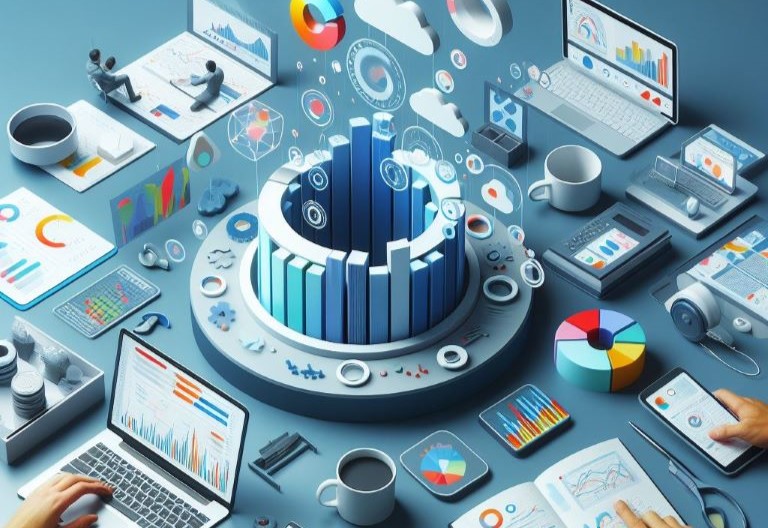data visualization | Mar 6, 2024
Unveiling the Power of Data Visualization Software, Tools, and Platforms

In today's data-driven world, the ability to transform complex information into visually appealing and understandable formats is paramount. Data visualization software, tools, and platforms play a pivotal role in this domain, offering diverse functionalities and features to cater to various needs.
What is Data Visualization
Data visualization is the art of representing data in graphical or visual formats, such as charts, graphs, and maps, to help people understand the patterns, trends, and insights within the data. The primary goal of data visualization is to communicate complex information in a more accessible and intuitive way, making it easier for individuals to comprehend, analyze, and derive meaningful conclusions from the data.
Effective data visualization can simplify complex datasets, highlight key patterns, relationships, and outliers, and provide a clear and concise means of conveying information. It is widely used in various fields, including business, science, finance, healthcare, and more, to present insights and aid data-driven decision-making processes.
Exploring Data Visualization Software
Several prominent data visualization software options dominate the market, providing different types of graphs and charts, with some specialized in AI analysis or interactive data visualization. Let's explore a few of them:
-
- Build dynamic dashboards for a complete data overview
- Use natural language to ask and get instant insights
- Data connectivity of on-premises and cloud data sources
- AI-powered Analytics
- Power BI is popular tool for business analytics and data visualization. It integrates well with other Microsoft products and services and offers a range of visualization options.
-
- Drag-and-drop Interface
- Real-Time data collaboration
- Vast library of visualizations
- Embed Tableau visualizations and integrate with other tools
- Tableau is renowned for its data visualization and business intelligence capabilities. Its drag-and-drop interface allows users to create interactive and shareable dashboards, making it a favorite among analysts and business users.
-
- Intuitive drag-and-drop functionality
- Diverse chart types (bar, line, pie, etc.)
- Interactive capabilities for enhanced exploration
- Effortlessly analyze pivoted/multi-dimensional data
- Advanced analytics and data manipulation tools
- Ottava stands out as a versatile tool, known for its user-friendly interface and extensive customization options. Its robust features enable users to create compelling visuals from complex multi-dimensional datasets effortlessly.
-
- Data-driven approach for creating custom visualizations
- Wide range of possibilities for specific needs
- Community support
- Responsive and animated visualizations
- D3.js (Data-Driven Documents) is a JavaScript library for producing dynamic, interactive data visualizations in web browsers. It gives developers the flexibility to create custom visualizations and supports the binding of data to the Document Object Model (DOM).
-
- LookML(proprietary modeling language) provides a simplified and consistent framework for both technical and non-technical users.
- Interactive interface for ad-hoc queries, filters, and drill-downs
- Collaboration via dashboard sharing, scheduled reports, commenting, and data-driven alerts
- Data governance and security with access controls, permissions, and auditing features
- Embedding and integration capabilities of dashboards and visualizations
- Looker is a business intelligence (BI) and data analytics platform that enables organizations to explore, analyze, and visualize their data. Acquired by Google Cloud in 2020, Looker is designed to make data accessible and actionable for a wide range of users, including business analysts, data engineers, and decision-makers.
Each tool uniquely meets specific demands, whether for user-friendly analytics, custom visualizations, collaborative insights, or comprehensive business intelligence within various industries. Looker stands out for its user-friendly BI interface, seamlessly integrating with diverse data sources. D3.js, a dynamic JavaScript library, excels in crafting custom and interactive visualizations for web browsers. Ottava shines in pivoted data analysis, fostering real-time teamwork. Tableau leads with an intuitive platform for dynamic dashboard creation, while Power BI, deeply integrated into the Microsoft ecosystem, facilitates seamless data visualization. The best data visualization tool is the one that aligns with the needs.
The Impact of Data Visualization Platforms
Data visualization platforms have revolutionized the way businesses and individuals comprehend and analyze complex information. By transforming raw data into visually appealing and easily understandable charts, graphs, and dashboards, these platforms enhance decision-making processes across various industries.
The impact is profound, as these data visualizers empower users to identify patterns, trends, and insights that might otherwise remain obscured in a sea of numbers. Furthermore, data visualization fosters effective communication by presenting information in a compelling and accessible manner, enabling stakeholders to grasp key concepts swiftly.
Businesses leverage these platforms to streamline reporting, monitor key performance indicators, and communicate data-driven strategies. The accessibility of real-time, interactive visualizations facilitates a more agile response to changing circumstances, allowing organizations to adapt swiftly in dynamic environments. In essence, data visualization platforms not only enhance analytical capabilities but also play a pivotal role in driving informed decision-making, fostering innovation, and promoting a deeper understanding of complex datasets throughout various sectors.
Conclusion: Visualizing the Future
Data visualization tools or platforms empower individuals and organizations to make data-driven decisions effectively. As technology advances, these tools not only facilitate the comprehension of complex data but also open new frontiers for leveraging its power. The transformative impact of interactive visualizations, exemplified by dynamic features and real-time analyses, underscores the ongoing evolution of this field. In essence, data visualization is not merely a static snapshot of information; it is a dynamic force shaping the future of analytical capabilities and strategic insights across diverse sectors.
